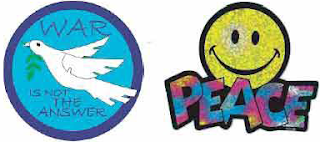1. Warm up activity:
Discuss in pairs the following:
□ How do you feel about the need for peace in society, state and the world?
□ What do you know about peace movements In the world?
2. Read the text and answer the questions that follow.
A peace movement is a social movement that seeks to achieve ideals such as the ending of a particular war (or all wars), minimize inter-human violence in a particular place or type of situation, including ban of guns, and is often linked to the goal of achieving world peace. Means to achieve these ends include advocacy of pacifism, non-violent resistance, diplomacy, boycotts, demonstrations, peace camps; supporting anti-war political candidates and banning guns, creating open government, direct democracy; supporting people who expose war-crimes or conspiracies to create wars, and making laws. Different organizations involved in peace movements may have some diverse goals, but one common goal is sustainability of peace.
Peace movement is basically an all-encompassing "anti-war movement". It is primarily characterized by a belief that human beings should not wage war on each other or engage in violent conflicts over language, race, natural resources, religion or ideology. It is believed that military power ia not the equivalent of justice. The peace movement tends to oppose the proliferation of dangerous technologies and weapons of mass destruction, in particular, nuclear weapons and biological warfare. Moreover, many object to the export of weapons including hand-held machine guns and grenades by leading economic to lesser developed rations.
The first peace movement appeared In 1815-1816. The first such movement In toe United State* was the New York Peace Society, founded in 1*15 by the theologian David Low Dodge, and the Massachusetts Peace Society. It became an active organization, holding regular weekly meeting*, and producing literature which was spread as far a? Gibraltar and Malta, describing toe horrors of war and advocating pacifism on Christian grounds, The London Peace Society (also known as toe Society for toe protection of Permanent and Universal Peace) wae formed in 1816 to promote permanent and universal peace by toe philanthropist William Alien, hi the 1840s, British women formed 'Olive Leaf Circles' groups of around 15 to 20 women, to discuss and promote pacifist idea*. The peace movement began to grow in influence by the mid nineteenth century. The London Peace Society, under the initiative of American consul to Birmingham, Elibu Bnrritt, and toe Revaraned Henry Richard, convened the first International Peace Congress In London in 1841. The congress decided on two aims: the ideal of peaceable arbitration in the uf&rirs of Tuoinre and toe creation of an international institution to achieve that.
Afterwards, peace organizations were set op in many countries. The United Nations was founded with toe primary objective to maintain peace and resolve inter-state conflicts in the world. Many treaties have been signed between many nations, a noteworthy one of which is toe nuclear non proliferation treaty. Everyone wants peace and the principles of non-violence.
3. Give the appropriate meanings of the following words. Also, indicate the part of speech of each word, change them into as many parts of speech as possible, and make sentences of your own with each changed form:
a. diplomacy
b. boycott
c. diverse
d. sustainability
e. potential
4. Make sentences of your own with the following words/expressions:
a. horrors of war
b. equivalent
c. hand-held
d. campaign
e. set up
f. noteworthy
g. ban
h. voiced
i. mass destruction
5. What do you mean by pacifism? Who is a pacifist?
6. What is the primary goal of a peace movement? What other activities of the peace movement are mentioned in the passage?
7. Mention some of the peace movements described in the passage.
8. In pairs, discuss what you think will be some effective measures for peace in your society and state. Report your discussion to the class.
9. Write a short article suggesting some measures that can be taken to ensure peace in the world.
If you want read the next unit please click the link below:
Unit Thirteen: Greatest Scientific Achievements







0 Comments:
Post a Comment